- Types of Sailboats
- Parts of a Sailboat
- Cruising Boats
- Small Sailboats
- Design Basics
- Sailboats under 30'
- Sailboats 30'-35
- Sailboats 35'-40'
- Sailboats 40'-45'
- Sailboats 45'-50'
- Sailboats 50'-55'
- Sailboats over 55'
- Masts & Spars
- Knots, Bends & Hitches
- The 12v Energy Equation
- Electronics & Instrumentation
- Build Your Own Boat
- Buying a Used Boat
- Choosing Accessories
- Living on a Boat
- Cruising Offshore
- Sailing in the Caribbean
- Anchoring Skills
- Sailing Authors & Their Writings
- Mary's Journal
- Nautical Terms
- Cruising Sailboats for Sale
- List your Boat for Sale Here!
- Used Sailing Equipment for Sale
- Sell Your Unwanted Gear
- Sailing eBooks: Download them here!
- Your Sailboats
- Your Sailing Stories
- Your Fishing Stories
- Advertising
- What's New?
- Chartering a Sailboat
- Cruising Yachts 30' to 35'
- Hunter 31 Sailboat

The Hunter 31 Sailboat Specs & Key Performance Indicators
The Hunter 31, a B&R rigged masthead sloop, was designed by Cortland Steck and built in the USA by Hunter Marine.
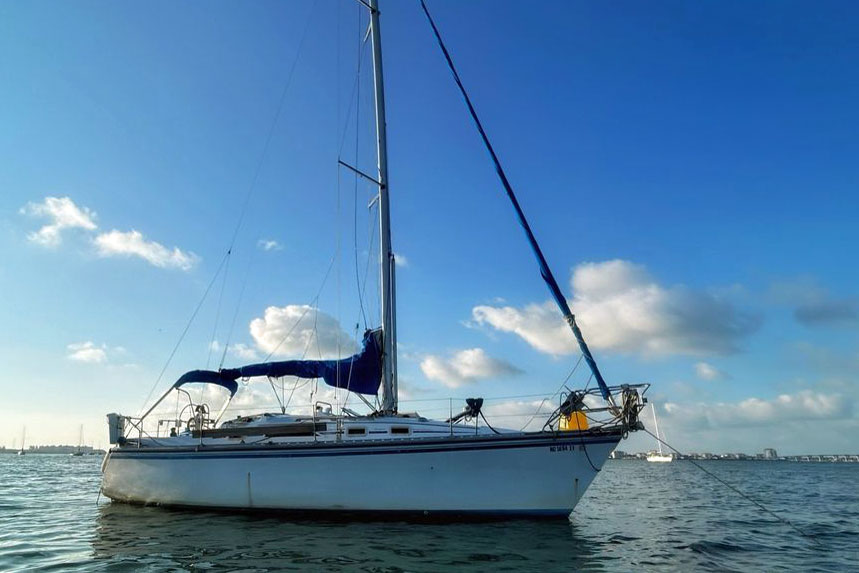
Published Specification for the Hunter 31
Underwater Profile: Fin keel & spade rudder
Hull Material: GRP (Fibreglass)
Length Overall: 31'4" (9.6m)
Waterline Length: 26'3" (8.0m)
Beam: 10'11" (3.4m)
Draft: 5'3" (1.6m)
Rig Type: B&R
Displacement: 9,700lb (4,400kg)
Ballast: 4,000lb (1,814kg)
Designer: Cortland Steck
Builder: Hunter Marine (USA)
Year First Built: 1983
Year Last Built: 1987
Published Design Ratios for the Hunter 31
Sail Area/Displacement Ratio : 16.2
Ballast/Displacement Ratio: 41.2
Displacement/Length Ratio: 239
Comfort Ratio: 22.4
Capsize Screening Formula: 2.1
Read more about these Key Performance Indicators...
Summary Analysis of the Design Ratios for the Hunter 31
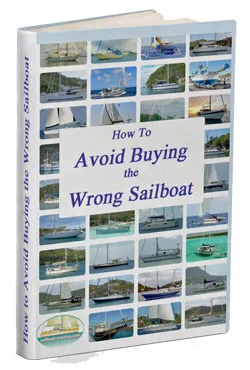
1. A Sail Area/Displacement Ratio of 16.2 suggests that the Hunter 31 will, in the right conditions, approach her maximum hull speed readily and satisfy the sailing performance expectations of most cruising sailors.
2. A Ballast/Displacement Ratio of 41.2 means that the Hunter 31 will stand up well to her canvas in a blow, helping her to power through the waves.
3. A Displacement/Length Ratio of 239, tells us the Hunter 31 is a moderate displacement cruiser, which means she'll carry all your cruising gear without it having a dramatic effect on her performance. Most of today's sailboats intended for offshore cruising fall into this displacement category.
4. Ted Brewer's Comfort Ratio of 22.4 suggests that crew comfort of a Hunter 31 in a seaway is similar to what you would associate with the motion of a coastal cruiser with moderate stability, which is not the best of news for anyone prone to seasickness.
5. The Capsize Screening Formula of 2.1 tells us that a Hunter 31 would not be as good a choice of sailboat for ocean passage-making, owing to the increased risk of capsize in strong winds and heavy seas when compared to a sailboat with a CSF of less than 2.0.
The Hunter 31 Sailboat: A Review
The Hunter 31 is a popular model from Hunter Marine, an American company that has been building quality sailboats since 1973. The Hunter 31 was first introduced in 1983 and was designed by Cortland Steck. It was produced until 1987, when it was replaced by the Hunter 33.5. In 2006, Hunter Marine launched a new version of the Hunter 31, which is sometimes referred to as the Hunter 31-2 or the Hunter 30/31. This boat was designed by Glenn Henderson and was in production until 2014. In this article, we will focus on the original Hunter 31, but we will also mention some of the differences and similarities with the newer model.
The Hunter 31 is a sloop-rigged cruiser that can accommodate up to six people in two cabins and a convertible salon. It has a fin keel, a spade rudder and a single wheel steering system. The boat has a self-tacking jib and an optional in-mast furling system for easy sail handling. The boat also has a Yanmar diesel engine with a low fuel capacity of 12 gallons.
The Hunter 31 is a boat that offers a lot of features and benefits for recreational sailors. Here are some of the main aspects of the boat that you might want to know more about:
Overview The Hunter 31 is a boat that combines performance, comfort and convenience. It is a boat that can sail well in light to moderate winds, thanks to its efficient hull shape and rig design. It is also a boat that can handle rougher conditions, thanks to its high stability and stiffness. The boat has a PHRF rating of 174, which means it is faster than some of its competitors in its size range.
The Hunter 31 is also a boat that offers plenty of space and amenities for living aboard. It has a beam of 10 feet and 11 inches, which gives it a roomy interior and a wide cockpit. It has two private cabins, one forward and one aft, each with a double berth and storage space. It has a large salon with a U-shaped dinette that can convert into another double berth, a navigation station with an electrical panel and instruments, and a galley with a two-burner stove, an oven, a sink, an icebox and ample counter space. It has a head with a marine toilet, a sink and a shower. It also has plenty of ventilation and natural light, thanks to its numerous ports, hatches and skylights.
The Hunter 31 is also a boat that is easy to operate and maintain. It has a simple and user-friendly layout, with all the controls and lines led back to the cockpit. It has an engine access panel under the companionway steps, which makes it easy to check and service the engine. It has a molded fiberglass hull and deck, which are durable and easy to clean.
Accommodation The Hunter 31 can sleep up to six people in two cabins and a convertible salon. The forward cabin has a V-shaped double berth with storage drawers underneath, shelves along the hull sides, an overhead hatch and two opening ports. The aft cabin has an athwartships double berth with storage lockers underneath, shelves along the hull sides, an opening port and an overhead hatch. The salon has a U-shaped dinette that can convert into another double berth with storage lockers underneath, shelves along the hull sides, four opening ports and two overhead hatches. The head is located on the port side of the salon, opposite the galley. It has a marine toilet with a holding tank, a sink with hot and cold water, a shower with a sump pump, storage cabinets, an opening port and an overhead hatch.
The accommodation layout of the newer Hunter 31-2 is slightly different from the original model. The forward cabin has more headroom and more storage space than the original model. The aft cabin has less headroom but more floor space than the original model. The salon has a straight settee on the starboard side instead of a navigation station, and a smaller dinette on the port side that can convert into a single berth. The head is located on the starboard side of the salon, opposite the galley. It has a separate shower stall with a folding door, which makes it more spacious and comfortable than the original model.
Hull and Deck The Hunter 31 has a solid fiberglass hull with a balsa core sandwich construction for the deck. The hull has a moderate displacement of 9,700 pounds and a ballast of 4,000 pounds. The hull has a fin keel with a draft of 5 feet and 3 inches, which gives it good performance and stability. The hull also has a spade rudder with a stainless steel shaft and bearings, which gives it good maneuverability and responsiveness. The deck of the Hunter 31 is designed for safety and convenience. It has a wide and flat foredeck with an anchor locker, an anchor roller and an electric windlass. It has stainless steel bow and stern pulpits, stanchions and lifelines. It has two dorade vents on the cabin top for ventilation. It has two large cockpit lockers for storage, one on each side of the wheel. It has a transom swim platform with a folding ladder and a shower. It also has a stern rail seat on each side of the cockpit, which provides extra seating and visibility.
The hull and deck of the newer Hunter 31-2 are similar to the original model, but with some improvements and modifications. The hull has a slightly longer waterline length of 28 feet, which increases its speed potential. The hull also has a shoal draft option of 3 feet and 11 inches, which makes it more suitable for shallow waters. The deck has a more modern and sleek appearance, with flush-mounted hatches, recessed handrails and an arch over the cockpit that supports the mainsheet traveler and the optional bimini top.
Mast and Rigging The Hunter 31 has a sloop rig with a deck-stepped mast and swept-back spreaders. The mast is made of anodized aluminum and has internal halyards and wiring. The mast height is 46 feet and 7 inches, which makes it suitable for most bridges and marinas. The mast also has an optional in-mast furling system for the mainsail, which makes it easier to reef and stow the sail.
The boat has a B&R rig, which is a fractional rig that eliminates the need for a backstay. This allows for a larger mainsail area and a smaller jib area, which improves the boat's performance in light winds and reduces its heeling tendency. The boat also has a self-tacking jib, which makes it easier to tack and trim the sail without changing sheets.
The boat has stainless steel standing rigging and low-stretch running rigging. The boat has two Lewmar self-tailing winches on the cabin top for halyards and reefing lines, and two Lewmar self-tailing winches on the coaming for jib sheets. The boat also has rope clutches, cam cleats, blocks, tracks and cars for adjusting the sails. The mast and rigging of the newer Hunter 31-2 are similar to the original model, but with some differences. The mast height is slightly lower at 46 feet, which reduces its windage and weight aloft. The mast also has an optional in-boom furling system for the mainsail, which gives it more sail shape control than the in-mast furling system. The boat also has an optional spinnaker or gennaker for downwind sailing.
Keel and Rudder The Hunter 31 has a fin keel which is bolted to the hull with stainless steel bolts and nuts. The keel draft is 5 feet and 3 inches, which gives it good performance upwind and downwind. The keel also provides stability and balance to the boat. The boat has a spade rudder with a stainless steel shaft and bearings. The rudder draft is 5 feet, which matches the keel draft. The rudder also provides maneuverability and control to the boat.
The keel and rudder of the newer Hunter 31-2 are similar to the original model, but with some options. The boat has a shoal draft option of 3 feet and 11 inches, which reduces its draft by more than one foot. The boat also has an optional wing keel or twin keels, which increase its stability at low speeds or when anchored.
The above text was drafted by sailboat-cruising.com using GPT-4 (OpenAI’s large-scale language-generation model) as a research assistant to develop source material; we believe it to be accurate to the best of our knowledge.
Other sailboats in the Hunter range include:
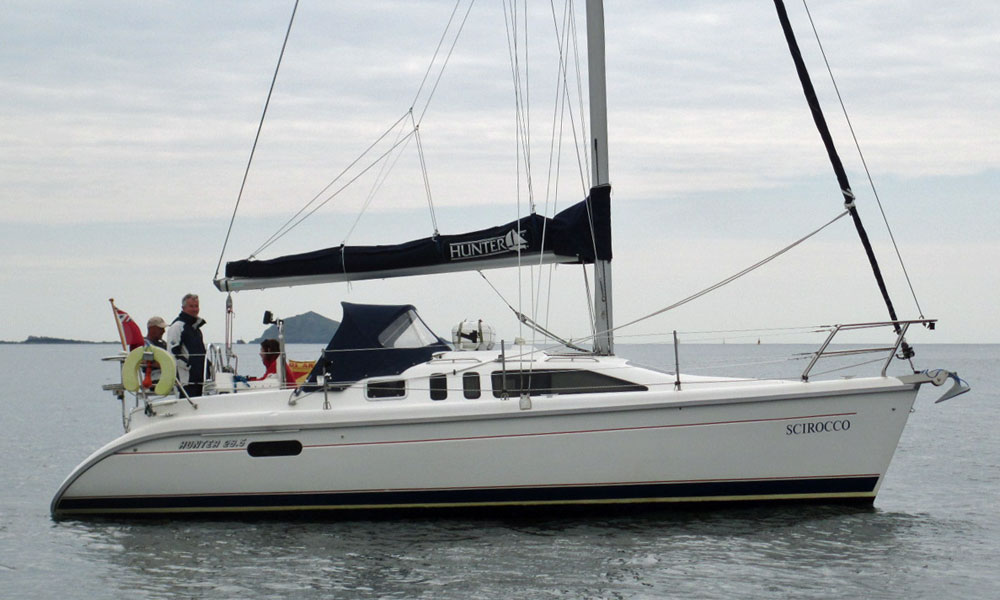
Recent Articles
Sovereign 51 Specs & Data
Aug 21, 24 05:54 AM
Taswell 43 Specs
Aug 21, 24 02:35 AM
Hood 38 Specs & Data
Aug 20, 24 03:35 PM
Here's where to:
- Find Used Sailboats for Sale...
- Find Used Sailing Gear for Sale...
- List your Sailboat for Sale...
- List your Used Sailing Gear...
Our eBooks...

A few of our Most Popular Pages...

Copyright © 2024 Dick McClary Sailboat-Cruising.com
- BOAT OF THE YEAR
- Newsletters
- Sailboat Reviews
- Boating Safety
- Sails and Rigging
- Maintenance
- Sailing Totem
- Sailor & Galley
- Living Aboard
- Destinations
- Gear & Electronics
- Charter Resources
- Ultimate Boat Giveaway

Marlow-Hunter 31
- By Herb McCormick
- Updated: March 16, 2016
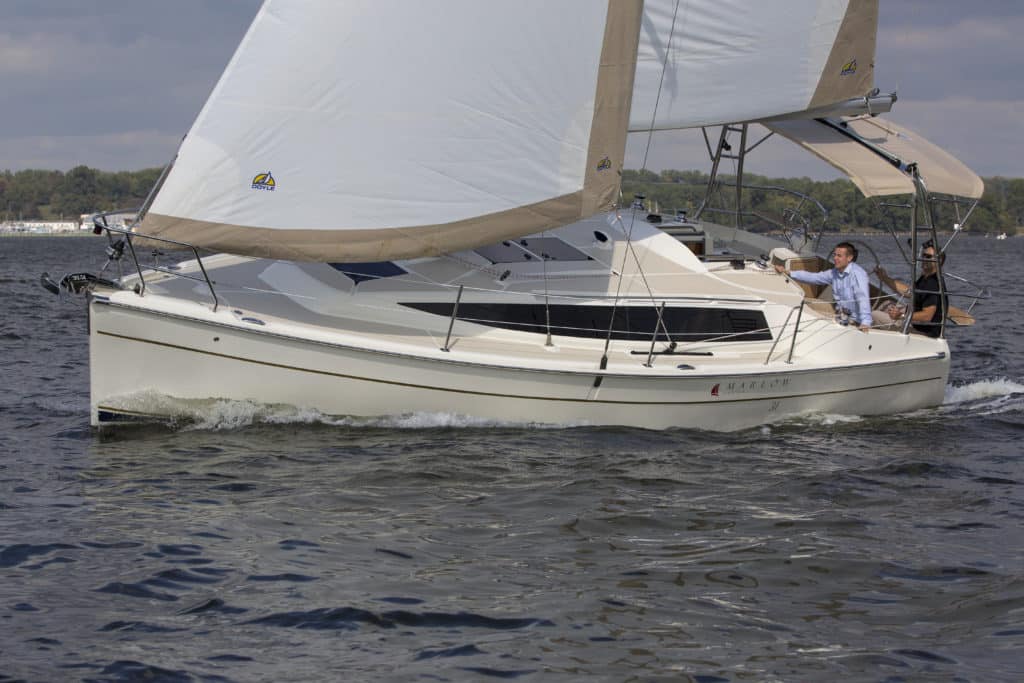
Once upon a time, I owned a J/30. As a racer/cruiser introduced in 1979, it lacked many cruising amenities, even for its era, but for a 30-footer it was plenty beamy (over 11 feet), and I always considered it a not-insubstantial vessel. Times change, of course, particularly with yacht designs, a point that was driven home as I stepped aboard the Marlow-Hunter 31 last fall. Thinking back on my cherished J boat, I had to smile. Though roughly a foot shorter than the latest offering from the well-established Florida builder, figuratively speaking, my old girl would have fit in this new 31-footer’s hip pocket. How was it even possible?
Well, the short answer is a quick summation of many of the characteristics shared by lots of contemporary production cruisers. Designers Glenn Henderson (a longtime Hunter hand) and David Marlow (a veteran powerboat builder who purchased the company three years ago) have incorporated a trendy hard chine just below the waterline and used it to maximize the dimensions and interior volume. Long waterline? Check. Extended topsides? Check. Max beam (almost 12 feet!) carried well aft? Check.
Indeed, the Marlow-Hunter 31 is a thoroughly modern pocket cruiser that also includes many familiar Hunter features, including a B&R rig with swept-back spreaders that eliminate the backstay. You’re not finding that on any imports. But when you start to scratch the surface, it’s also abundantly clear that there’s some serious innovation happening here, particularly in the methods and materials used to piece the boat together. We tested the M-H 31 on Chesapeake Bay during last fall’s Boat of the Year trials, and got totally skunked on breeze: zero, nothing, nada. It happens. But while a couple of the judges and I vainly tried to put the boat through its paces, David Marlow and the third member of our panel, systems expert Ed Sherman of the American Boat and Yacht Council, disappeared below, two salty dogs lost in private banter. Whatever were they discussing? Later, during deliberations, Sherman spilled the beans. “We had a fascinating conversation,” he said. “He’s a man on a mission who really wants to reinvent the Hunter brand. Part of the way he’s doing that is to take a hard look at long-term durability while trying to build a product that’s easier for his factory workers to assemble. He’s invested a huge amount of time and R & D in developing a database of what works and what doesn’t. It blew me away.
“Most of his experience is in the powerboat sector, but he has a broad nautical background, so he’s got some knowledge of hydrodynamics, aerodynamics and structural build,” he continued. “It’s evident in the hull layup, for instance, with the use of Kevlar forward to increase impact resistance. They’ve made some phenomenal decisions in how to address cores, where they’re going to be applied, and the type of fiberglass they use in the overall laminate. It’s pretty amazing, and it was impressive to talk to him about it.”
There’s the overview on the construction side. Judge Tim Murphy discussed specifics. “There’s definitely a new sheriff in town,” he said. “They’re doing a lot of things really right. There are no chopper guns in the layup shop anymore. Now they’re using biaxial cloth, and it’s engineered so the stress is carried in the right direction. They’re also using vinylester resin, which will really work against osmosis. Below the waterline, the boat is solid fiberglass, but in the topsides and deck they’ve eliminated balsa core and replaced it with Nida-Core, a honeycomb panel that’s lighter and stiffer. All good things.”
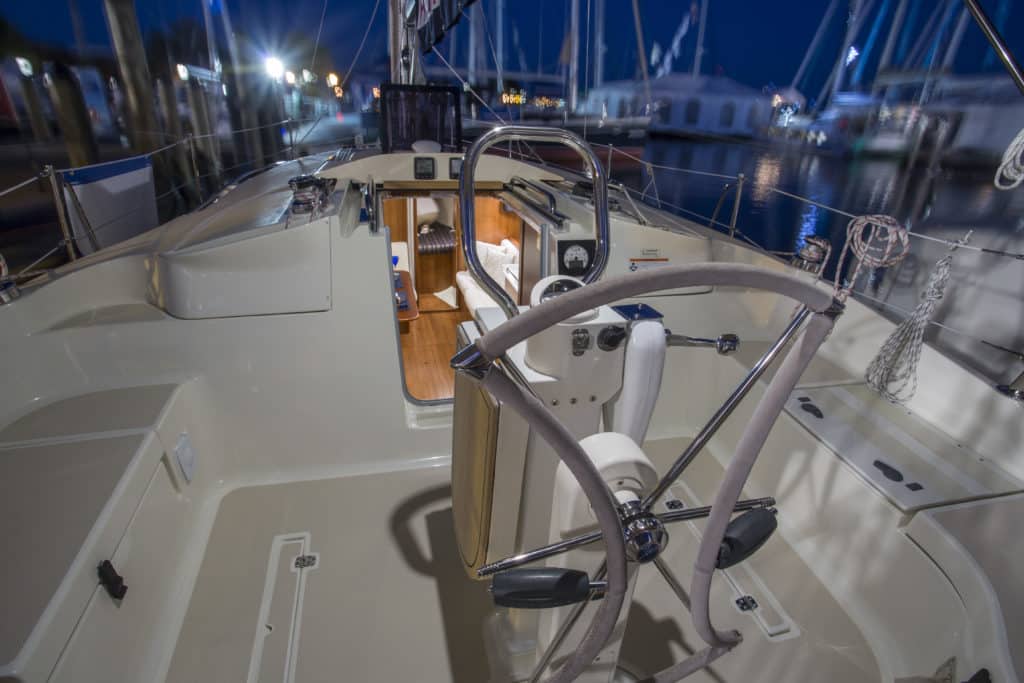
So, yes, a new day has dawned at Marlow-Hunter, especially on the manufacturing front. What about execution? The judges loved some items and questioned a few others, starting all the way aft, with the hatch in the transom opening into a dedicated storage locker for surfboards or kayaks. Let’s put it this way: Holes in boats that may allow the ingress of water make the judges very nervous.
Topsides, the centerpiece of the design is the expansive, beam-to-beam cockpit, which eschews traditional coamings to create the widest possible space. The coolest part, everyone agreed, was the nifty articulating Lewmar pedestal and steering wheel, operated with a foot pedal to swing from side to side so the helmsman can steer in comfort from either a windward or leeward position. (The wheel spokes also fold inward to permit easy access to the drop-down transom.) Despite the beam, with this arrangement, there’s no need for twin wheels.
As with previous Hunters, the traveler for the B&R mainsail is stationed atop a prominent arch, which also houses speakers, LED lights, a bimini and one end of the double-ended main sheet (the other is led to the cabin top). Over the years, I’ve sailed many Hunters with this setup, and it’s functional, though it does take some getting used to. (It’s tough to gauge where the traveler is positioned.) Judge Alvah Simon isn’t a fan, primarily because the arch necessitates a high gooseneck for the boom to clear it; this elevates the sail plan, and power in the B&R rig is really derived from the mainsail. Though our test boat was equipped with an optional in-mast furling main, Simon recommends the standard, traditional, fully battened one.
One last thing: Some members of our team, perhaps less nimble than they once were, wondered if it would be difficult getting into or out of the cockpit on a steep heel. (There is a step in the coachroof leading forward, but one of our judges initially mistook it for a seat.) With calm conditions, we didn’t get the chance to try.
Down below, the layout is spacious. There is a large head, a straight-line galley and roomy berths in the ends of the boat. Each is a bit of a trade-off. The forward cabin has great headroom but a slightly smaller V-berth. The aft bed, athwartships below the cockpit, is huge but in a more enclosed space. All in all, for well under $200,000, the Marlow-Hunter 31 is a whole lot of boat in a very manageable package. As for the company itself, we’re talking equal parts revolutionary and evolutionary.
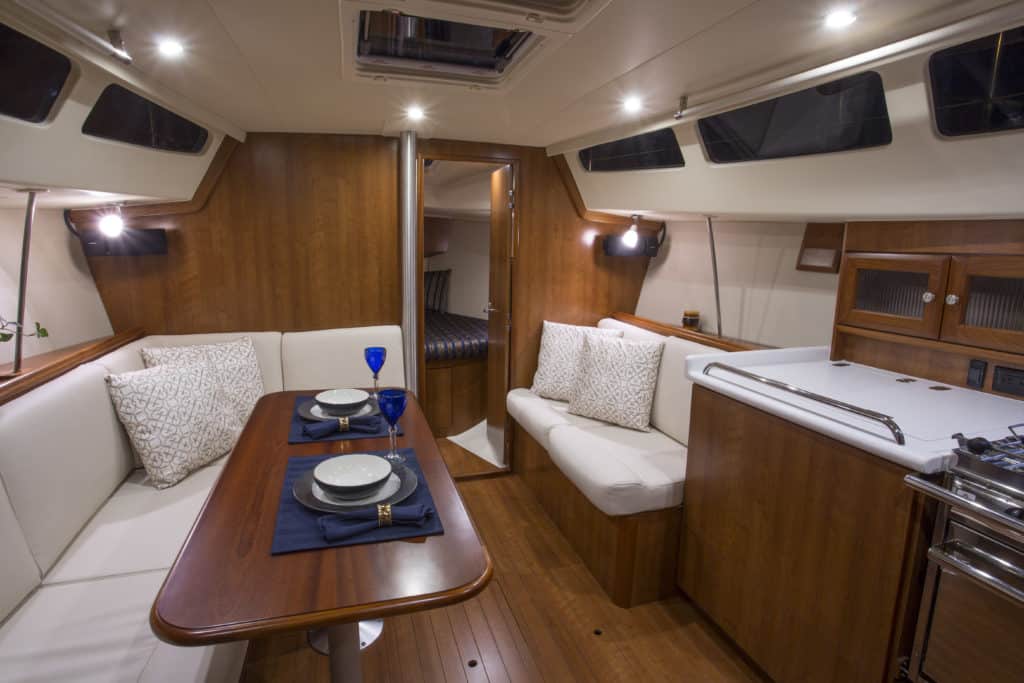
LOA: 32’4″ LWL: 28’9″ Beam: 11’10” Draft (shoal / deep): 4’5″ / 5’5″ Sail Area: 581 ft 2 Ballast (shoal / deep): 3,525/3,379 lb. Displacement (shoal / deep): 11,854/12,000 lb. Ballast/Displacement: 0.28 Displacement/Length: 205 Sail Area/ Displacement: 17.7 Water: 50 gal. Fuel: 21 gal. Holding: 20 gal. Hast Height (Standard): 46’7″ Engine: 29 hp Yanmar (saildrive) Designers: Glenn Henderson/David Marlow Price: $160,000
Marlow-Hunter LLC 386-462-3629 www.marlow-hunter.com
Herb McCormick is CW’s executive editor.
- More: 2011+ , 31 - 40 ft , Coastal Cruising , marlow-hunter , monohull , sailboat review , Sailboats
- More Sailboats

For Sale: 1984 Camper & Nicholsons 58

Alubat Updates OVNI Models

For Sale: Little Harbor 63 Ketch

Sailboat Review: Fountaine Pajot Aura 51

Cruising Tahiti: A Party in Paradise
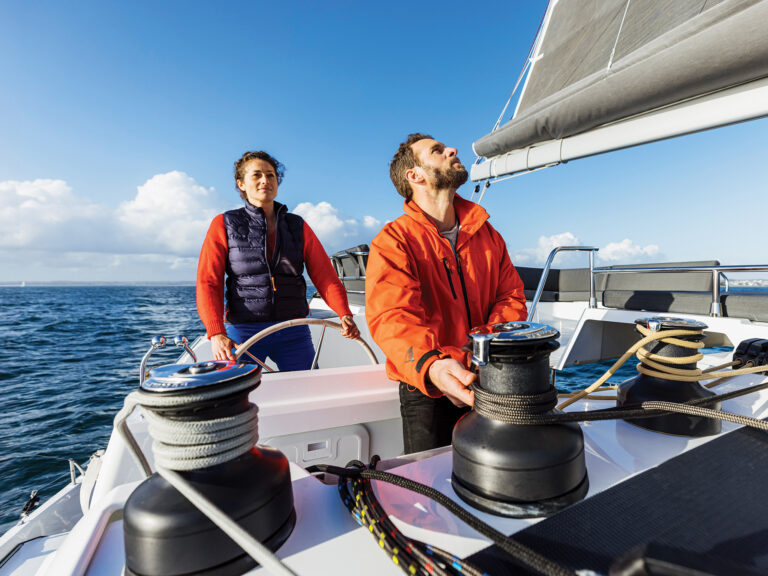
Introducing Bitter End’s Beach Bungalows
- Digital Edition
- Customer Service
- Privacy Policy
- Terms of Use
- Email Newsletters
- Cruising World
- Sailing World
- Salt Water Sportsman
- Sport Fishing
- Wakeboarding

T he Hunter 31 can easily be added to the list of "everyman sailboats" because of its relatively affordable price, the sheer number of hulls currently on the used boat market and the sloop's overall versatility as both daysailer and family cruiser.
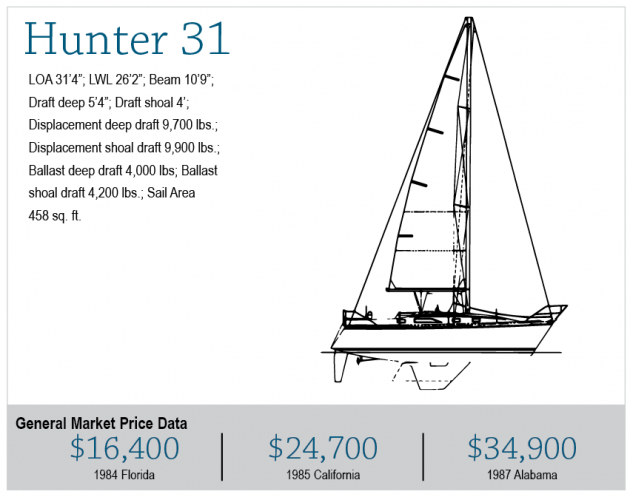
First impressions
Would-be boat owners looking for a bargain are likely to gravitate to the Hunter 31, which has a racy look with masthead rig and swept spreaders, and plenty of room above and below deck for friends to come aboard. The Hunter 31 doesn't look like a slow-moving tub or a traditional sloop from the 1960s or 1970s with overhangs and varnish-begging brightwork. Instead, it has the more contemporary lines found on boats made during the 1980s, with generous freeboard, a stainless steel destroyer wheel, tinted hatch covers, bow and stern pulpits, reverse transom and an aluminum toerail track similar to those pioneered by C&C. The deck is uncluttered given the overall length of the boat, although the sheer isn't the most elegant ever drawn.
The 31 was designed by Cortland Steck, who grew up racing dinghies from age 7 and later sailed larger boats offshore. In 1979, he graduated from the Westlawn School of Yacht Design and five years later established Cortland Steck Yacht Design. Steck has amassed more than 5,000 designs to his credit, including the Hunter 20, 34, 40 Legend, Starwind 223 and Hunter 25.5.
Construction
Many owners agree the Hunter 31 wasn't built with the notion that it would still be sailing far into the next century. Clearly not as rugged as some production boats, with the exception of its rock-solid hull, the overall build quality is the target of frequent criticism by owners. Complaints range from substandard winches to delamination on portions of the balsa-cored deck.
The hull was made of hand-laid, pre-cut fiberglass to ensure consistency. Hunter bonded a full-length internal frame and stringer system of unidirectional fiberglass directly to the hull to increase stiffness without adding undue weight. The chainplates were fastened to this framing system and led upward through the deck just outside the coachroof, creating more interior space and minimizing deck clutter. This design distributed the load to the frame and stringer system.
The keel is cast iron so rust will always be a factor where it's bolted to the hull. The rust tends to form on the crack where the metal meets the fiberglass. Although this joinery is covered with a thin layer of gelcoat at the factory, once the material wears away, cracks develop and a rust line becomes visible. Maintenance of this area is essential by carefully grinding and cleaning the boat after haul out, then recoating.
What to look for
Delamination may be found beneath the mast and compression post along with a weakened crossmember. Look for discoloration or mold.
The shower sump and icebox drain into the bilge, which is shallow and compartmentalized, an arrangement that allows stagnant water to become trapped and inaccessible. Owners report this can cause rotting of the cabin sole.
The bilge area under the engine can also collect water from rain entering through the companionway. This water can drain into the main bilge area, adding to what is already accumulated from the sump and icebox.
Leaks under the steering pedestal and at the cabin windows are common. These seals should be cleaned and recaulked. Some owners have replaced the fuel tank, claiming it's flimsy. As one owner wrote in an online forum, "I replaced that cheap plastic, sorry excuse for a fuel tank." Another sailor resorted to using a portable fuel tank rather than replace the original.
The fuel filter gauge is inside the starboard storage locker, where it is difficult to access or see. The integrated water and waste tanks are sensibly molded into the hull, but their screwed-down lids should be removed and resealed after 20 years to keep leaks and odors in check.
Prospective buyers should examine the cable-linked steering for wear.
The masthead rig features swept spreaders. The deck is uncluttered, except for lifelines, genoa track and shrouds, the latter attached nearer the coachroof than to the outside rail. The shroud placement allows crew to move more easily fore and aft for sail changes or foredeck work. The lifeline stanchions are mounted outboard, creating additional room on deck. The T-shaped cockpit is somewhat cramped due to the pedestal steering column, wheel and engine controls. The cockpit lockers are large enough to stow all sails and other equipment.
There's a big-boat feel once you go below. Headroom is 6 feet 3 inches in the spacious saloon, but the V-berth is tight for two adults. The head with sink and toilet is just outside the V-berth and fitted with a privacy door.
The overall layout is social, with a U-shaped galley to starboard that allows the cook to converse or otherwise take part in the goings on. The galley has a four-burner stove, two-basin sink and an icebox. It is abutted by a dinette that seats four.
The port side features a settee and full navigation station with chart table and light. The aft cabin is roomy. Teak paneling warms the saloon and other bulkheads. Plentiful windows provide light and cross ventilation. The boat carries 35 gallons of water.
The hulls made from 1983 to 1985 were fitted with a 13-horsepower, freshwater-cooled, Yanmar diesel. Later boats were beefed up with a 16-horsepower engine. Both versions proved reliable, but underpowered when motoring to windward or in a choppy sea. Engine power has been a source of owner complaints. Panels allow for good engine access. The boat carries 18 gallons of fuel.
One owner praised the 13-horsepower engine, noting Yanmar suggested running it full bore and then backing off 10% to find the ideal rpm. "Mine runs like a top and is happy at 3,000 rpm," he said. "I can make 6.1 knots in a calm to slight chop, running at 2,900."
The Hunter 31 gets good reviews for its sailing abilities. Although the light-displacement sloop can be tender in a gusty wind, overall it's a forgiving boat with a balanced helm. Owners contend it's a no-brainer to sail and a joy to singlehand.
Opinions vary about the boat's proclivities when sailing downwind because the puffed-out mainsail hits the swept-back spreaders and doesn't always fill properly.
A few Hunter 31 skippers advocated using instead a combination of genoa and spinnaker when possible.
The boat performs nicely on its mainsail, but once the wind exceeds 20 knots, one or two reefs are highly advised. It tracks admirably once in the groove but can be slow to heel and may round up in a heavy gust. A broad reach is not its fastest point of sail.
Generally, owners find little fault with the boat's sailing characteristics. As one put it, "More than once I looked like a sailing genius because the boat handles so well."
Although the original sales brochure described the Hunter 31 as a bluewater boat, it seems more suited as a coastal cruiser. Given that a used Hunter 31 can be purchased on average for $20,000, one in good condition with upgrades already installed would be a bargain.
Bottom line: For not much more than the price of a used car, you can have a heck of a lot of fun on this boat.
PRICE: The price for a used Hunter 31 ranges from nearly $35,000 for a model in excellent condition with upgrades, to $16,400 for a boat in poor condition. Most 31s are priced around $20,000.
DESIGN QUALITY: Designed by Cortland Steck, the masthead sloop features a choice of deep or shoal-draft keel, fiberglass hull, spade rudder and has a pleasing overall length-to-width ratio of 3-to-1.
CONSTRUCTION QUALITY: The Hunter 31 was built from 1983 to 1987 in Alachua, Florida, by Hunter Marine USA. Complaints have been voiced about undersized winches, a weak mainsheet traveler and poor craftsmanship in some areas below deck. As one owner put it, "Details were compromised due to pricing."
USER-FRIENDLINESS: Owners seem to agree the Hunter 31 is an easy boat to sail, simple to rig, somewhat tender but able to point high in a moderate breeze. By all accounts, it's made to singlehand. Mast height from the water is 47 feet 4 inches, enabling the boat to fit under most fixed highway bridges.
SAFETY: The Hunter 31 is often referred to as high and dry, mostly due to its generous freeboard. However, owners claim it gets pushed around by heavy seas, and its underpowered diesel leaves much to be desired. Grab rails on the coachroof provide a modicum of safety on deck.
TYPICAL CONDITION : The boats vary in condition. If maintenance has been kept up, the boat may be a good value, particularly if equipment upgrades were also made. Potential buyers should keep in mind the youngest 31 is now 27 years old and could be showing its age.
REFITTING: Common upgrades include adding a wind speed indicator and gauges for water, fuel and holding tank. Installing a beefier mainsheet traveler; larger winches and anchor roller are typical improvements.
SUPPORT: In 2012, Morgan Industries, parent company of Hunter Marine, filed for bankruptcy and was renamed Marlow-Hunter, which can be reached at www.marlow-hunter.com . For retail parts, contact www.shop.hunterowners.com . The Hunter Owners' Association, www.hunterowners.com is also a resource of support and information.
AVAILABILITY: Dozens of Hunter 31s are currently on the market, mostly listed. In early 2014, a project boat was being offered at $10,000 and eBay was auctioning a 1984 model for $6,900.
INVESTMENT AND RESALE: Because of its low-price on the used boat market, there is only moderate resale value.
Also in Used Boat Notebook
- Hunter Passage 42
- Pearson Rhodes 41
- Santa Cruz 52
- Allied Princess 36
- Kelly-Peterson 46
Also from David Liscio
- Chasing a dream
- The wide, wide world of multihulls
- Flares are expired. Now what?
- Saved from the scrap heap
- Pedal to the Medal
× You are using an outdated browser. Please upgrade your browser to improve your experience.
We Ship Worldwide! | FREE SHIPPING! for US Continental orders over $99. Click for details.

Shopping Cart
Your cart is currently empty..
FREE SHIPPING! for US Continental orders over $99 click for details
Hunter 31 - Sailboat Data, Parts & Rigging

Sailboat data, rig dimensions and recommended sail areas for Hunter 31 sailboat. Tech info about rigging, halyards, sheets, mainsail covers and more.
Sailboat Data directory for over 8,000 sailboat designs and manufacturers. Direct access to halyards lengths, recommended sail areas, mainsail cover styles, standing rigging fittings, and lots more for all cruising and racing sailboats.
MAURIPRO Sailing offers a full range of sailboat and sailing information to help you find the correct sailboat part, one that properly would fit your sailboat and sailing style. Our sailor's and sailboat owner support team are ready to talk with you about your specific sailing needs, coming regatta, or next sailing adventure.
From all at MAURIPRO, let's Go Sailing!
Copyright © 2024 MAURIPRO Sailing LLC.


1986 Hunter 31 Technical Specs
General data about hunter 31.
| Brand | |
| Model | |
| Boat Type | |
| Category | |
| Year Of Production | |
| Condition (New/Used) | |
| Country | |
| Fuel (Gas/Diesel) | |
| Hull Material Used | |
| Length | |
| Selling Price | |
Engine and Power Specs
| Engine manufacturer | |
| Engine Horsepower |
Dimensions And Wieght
| LOA (Length Overall) | |
| Displacement (Weight) | |
| Boat Maximum Draft | |
| Beam Width | |
| Ballast System Weight |
Detailed Specifications
| Number of Heads (Watercraft) | |
| Gas Tank Size | |
| Drinking Water Tank |
Features And Equipments
Other equipments.
| Wind |
| Teak folding cockpit table |
| Teak drink holder at helm |
| Sunbrella cover for helm and companionway |
| Stern boarding ladder |
| Ss sink with pressure water |
| Self-tailing winches |
| Rope clutches |
| New furler for genoa |
| Mainsail with cover |
| Lots of counter space |
| Long mainsheet traveler |
| Fuel guage |
| Forward cabin with v-berth and locker |
| Compounded and waxed april 2021 |
Interior Specifications
| Ice box |
Engine And Mechanical Specs
| Marine ac-heat-dehumidify |
Electronical And Electrical Info
| West marine multifunction |
| Vhf radio |
| Raymarine autopilot with st6002 controller |
| Garmin 541 chartplotter |
| Compass steering |
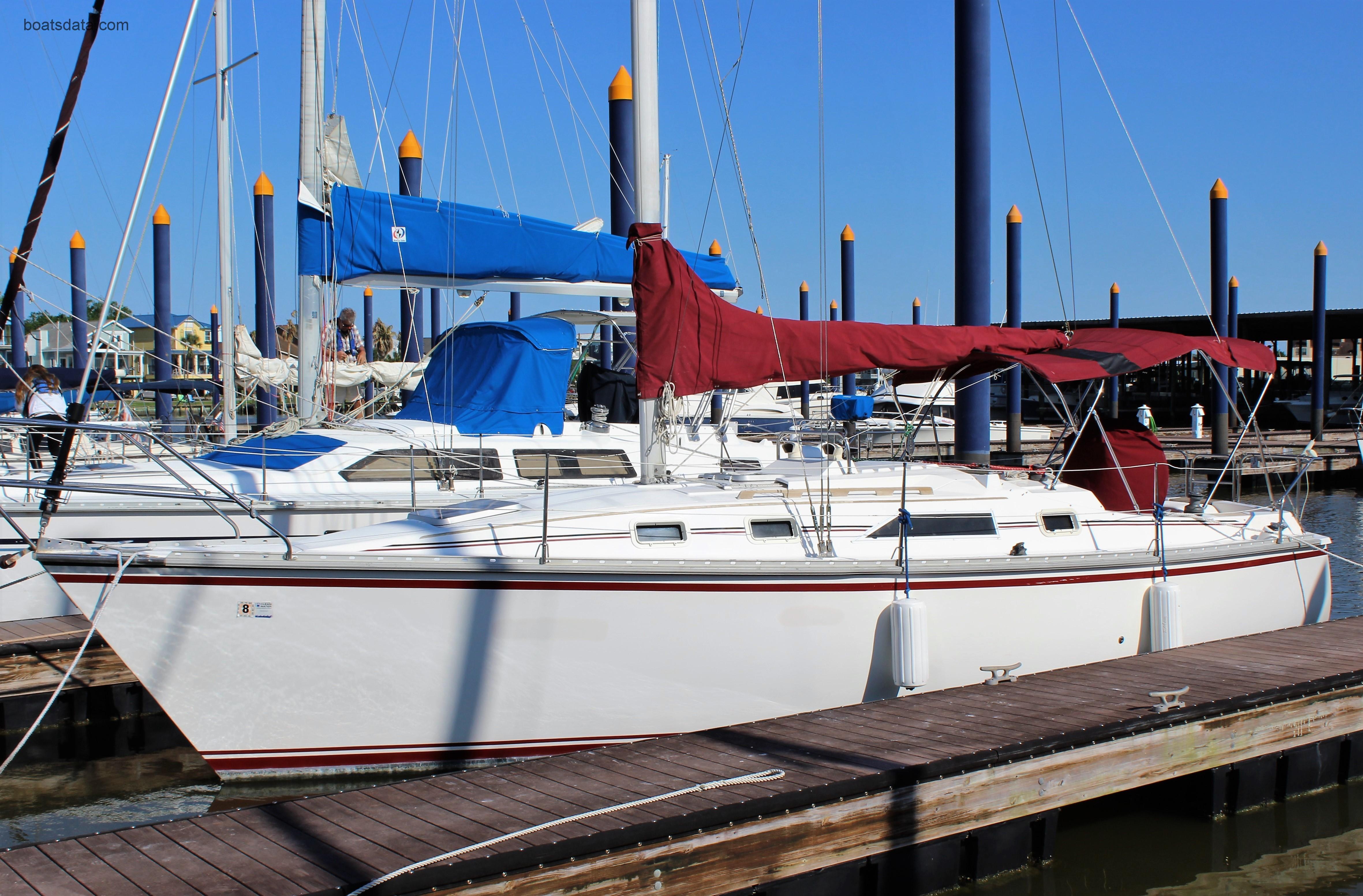
More 31 models
- Hunter provided us with the latest version of its 31 service repair manual
- Find All mechanical and electrical parts and accessories of Hunter 31 Sail here
Hunter 31 competitors

Sparkman & Stephens
Channel 31 hunter
The channel 31 hunter is a 30.75ft fractional sloop designed by david thomas/ken freivokh and built in fiberglass by hunter boats ltd. (uk) since 2000..
The Channel 31 hunter is a moderate weight sailboat which is a reasonably good performer. It is stable / stiff and has a good righting capability if capsized. It is best suited as a coastal cruiser.
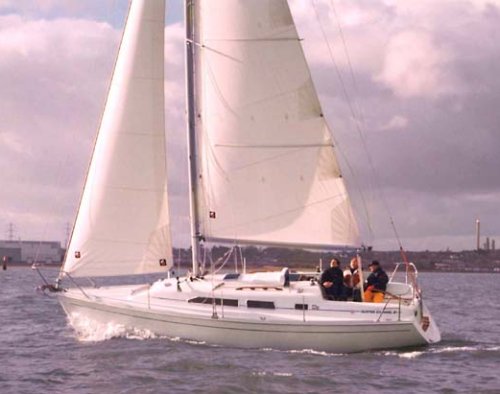
Channel 31 hunter for sale elsewhere on the web:

Main features
| Model | Channel 31 hunter | ||
| Length | 30.75 ft | ||
| Beam | 10.33 ft | ||
| Draft | 4.08 ft | ||
| Country | United Kingdom (Europe) | ||
| Estimated price | $ 0 | ?? |
Login or register to personnalize this screen.
You will be able to pin external links of your choice.

See how Sailboatlab works in video
| Sail area / displ. | 16.14 | ||
| Ballast / displ. | 37.34 % | ||
| Displ. / length | 223.57 | ||
| Comfort ratio | 23.47 | ||
| Capsize | 1.95 |
| Hull type | Monohull twin Keel | ||
| Construction | Fiberglass | ||
| Waterline length | 26.67 ft | ||
| Maximum draft | 4.08 ft | ||
| Displacement | 9500 lbs | ||
| Ballast | 3547 lbs | ||
| Hull speed | 6.92 knots |

We help you build your own hydraulic steering system - Lecomble & Schmitt
| Rigging | Fractional Sloop | ||
| Sail area (100%) | 451 sq.ft | ||
| Air draft | 0 ft | ?? | |
| Sail area fore | 0 sq.ft | ?? | |
| Sail area main | 0 sq.ft | ?? | |
| I | 0 ft | ?? | |
| J | 0 ft | ?? | |
| P | 0 ft | ?? | |
| E | 0 ft | ?? |
| Nb engines | 1 | ||
| Total power | 18 HP | ||
| Fuel capacity | 0 gals |
Accommodations
| Water capacity | 0 gals | ||
| Headroom | 0 ft | ||
| Nb of cabins | 0 | ||
| Nb of berths | 0 | ||
| Nb heads | 0 |
Builder data
| Builder | Hunter Boats Ltd. (UK) | ||
| Designer | David Thomas/Ken Freivokh | ||
| First built | 2000 | ||
| Last built | 0 | ?? | |
| Number built | 0 | ?? |
Modal Title
The content of your modal.
Personalize your sailboat data sheet
Great choice! Your favorites are temporarily saved for this session. Sign in to save them permanently, access them on any device, and receive relevant alerts.
- Sailboat Guide
2006 Hunter 31
- Description
Seller's Description
2006 Hunter 31 Sloop
This Hunter is comfortable down below and is designed to be easily single-handed!
The roomy cockpit has a walk-through transom with a swim step and ladder, a freshwater shower, and a folding steering wheel to make access easier.
On the Navpod is a touchscreen Garmin GPS-chartplotter, a wind instrument, speed, depth, and an Autopilot.
She has a wing keel of 4 feet and includes a 21 HP Yanmar engine when needed.
Down below, you’ll find 2 cabins with a queen size berth aft and the standard V-berth forward. The enclosed head has a shower.
In the main cabin, the galley consists of the propane stove/oven, storage cabinets, fridge, and sink.
The dinette is to starboard and is a fold-down table to make space for moving to the forward cabin or unfold it for everyone to have dining space or a spirited game of cards.
She’ll sleep up to 6 comfortably. Are you and your crew ready for new adventures?
Down below, you’ll find 2 cabins with a queen size berth aft and the standard V-berth forward. The enclosed head does include a shower.
In the main cabin, the galley consists of the propane stove / oven, fridge, and sink.
Rig and Sails
Auxilary power, accomodations, calculations.
The theoretical maximum speed that a displacement hull can move efficiently through the water is determined by it's waterline length and displacement. It may be unable to reach this speed if the boat is underpowered or heavily loaded, though it may exceed this speed given enough power. Read more.
Classic hull speed formula:
Hull Speed = 1.34 x √LWL
Max Speed/Length ratio = 8.26 ÷ Displacement/Length ratio .311 Hull Speed = Max Speed/Length ratio x √LWL
Sail Area / Displacement Ratio
A measure of the power of the sails relative to the weight of the boat. The higher the number, the higher the performance, but the harder the boat will be to handle. This ratio is a "non-dimensional" value that facilitates comparisons between boats of different types and sizes. Read more.
SA/D = SA ÷ (D ÷ 64) 2/3
- SA : Sail area in square feet, derived by adding the mainsail area to 100% of the foretriangle area (the lateral area above the deck between the mast and the forestay).
- D : Displacement in pounds.
Ballast / Displacement Ratio
A measure of the stability of a boat's hull that suggests how well a monohull will stand up to its sails. The ballast displacement ratio indicates how much of the weight of a boat is placed for maximum stability against capsizing and is an indicator of stiffness and resistance to capsize.
Ballast / Displacement * 100
Displacement / Length Ratio
A measure of the weight of the boat relative to it's length at the waterline. The higher a boat’s D/L ratio, the more easily it will carry a load and the more comfortable its motion will be. The lower a boat's ratio is, the less power it takes to drive the boat to its nominal hull speed or beyond. Read more.
D/L = (D ÷ 2240) ÷ (0.01 x LWL)³
- D: Displacement of the boat in pounds.
- LWL: Waterline length in feet
Comfort Ratio
This ratio assess how quickly and abruptly a boat’s hull reacts to waves in a significant seaway, these being the elements of a boat’s motion most likely to cause seasickness. Read more.
Comfort ratio = D ÷ (.65 x (.7 LWL + .3 LOA) x Beam 1.33 )
- D: Displacement of the boat in pounds
- LOA: Length overall in feet
- Beam: Width of boat at the widest point in feet
Capsize Screening Formula
This formula attempts to indicate whether a given boat might be too wide and light to readily right itself after being overturned in extreme conditions. Read more.
CSV = Beam ÷ ³√(D / 64)
Deep keel version Draft: 5.5’/1.68 m Displacement: 8,390 lbs/3,806 kg Ballast: 2,456 lbs/1,114 kg AKA HUNTER 30 (2005).
This listing is presented by PopYachts.com . Visit their website for more information or to contact the seller.
View on PopYachts.com
Embed this page on your own website by copying and pasting this code.
- About Sailboat Guide
©2024 Sea Time Tech, LLC
This site is protected by reCAPTCHA and the Google Privacy Policy and Terms of Service apply.

IMAGES
COMMENTS
A boat with a BN of 1.6 or greater is a boat that will be reefed often in offshore cruising. Derek Harvey, "Multihulls for Cruising and Racing", International Marine, Camden, Maine, 1991, states that a BN of 1 is generally accepted as the dividing line between so-called slow and fast multihulls.
The Hunter 31 is a comfortable coastal cruiser. "Classic Plastic" from our November 2010 issue. Hunter Marine introduced the Hunter 31 in 1983, and it remained in production for four years. My 1986 Hunter 31, which I named Aquarius, was 3 years old when I acquired it, and it had only been lightly used. I found it fun to sail.
The Hunter 31 Sailboat: A Review. The Hunter 31 is a popular model from Hunter Marine, an American company that has been building quality sailboats since 1973. The Hunter 31 was first introduced in 1983 and was designed by Cortland Steck. It was produced until 1987, when it was replaced by the Hunter 33.5. In 2006, Hunter Marine launched a new ...
The Hunter 31 is a 31.33ft b&r designed by Cortland Steck and built in fiberglass by Hunter Marine (USA) between 1983 and 1987. The Hunter 31 is a moderate weight sailboat which is a reasonably good performer. It is very stable / stiff and has a low righting capability if capsized. It is best suited as a coastal cruiser. The fuel capacity is ...
The Hunter 31 is a small recreational keelboat, built predominantly of fiberglass, with wood trim.It has a reverse transom, a length overall of 31.33 ft (9.5 m), a waterline length of 26.25 ft (8.0 m), displaces 9,700 lb (4,400 kg) and carries 4,000 lb (1,814 kg) of ballast.The boat has a draft of 5.30 ft (1.62 m) with the standard keel and 4.00 ft (1.22 m) with the optional shoal draft keel.
Hunter 31 is a 31′ 3″ / 9.6 m monohull sailboat designed by Cortland Steck and built by Hunter Marine between 1983 and 1987. ... The lower a boat's ratio is, the less power it takes to drive the boat to its nominal hull speed or beyond. Read more. Formula. D/L = (D ÷ 2240) ÷ (0.01 x LWL)³ D: Displacement of the boat in pounds. LWL ...
By Rupert Holmes. November 10, 2015. The new Marlow-Hunter 31 is a cruising sailboat built to a high standard, offering an unusually large amount of space for its length—and with the benefit of a choice of shoal or deep-draft keel. A marked chine in the hull's after sections helps to improve stability and adds volume in this part of the boat.
The Marlow hunter 31 is a 32.35ft b&r fractional designed by Glenn Henderson and built in fiberglass by Hunter Marine (USA) since 2015. The Marlow hunter 31 is a moderate weight sailboat which is a reasonably good performer. It is stable / stiff and has a low righting capability if capsized. It is best suited as a coastal cruiser.
Marlow-Hunter 31 is a 32′ 4″ / 9.9 m monohull sailboat designed by Glenn Henderson and built by Hunter Marine starting in 2015. ... The lower a boat's ratio is, the less power it takes to drive the boat to its nominal hull speed or beyond. Read more. Formula. D/L = (D ÷ 2240) ÷ (0.01 x LWL)³ D: Displacement of the boat in pounds. LWL ...
The aft bed, athwartships below the cockpit, is huge but in a more enclosed space. All in all, for well under $200,000, the Marlow-Hunter 31 is a whole lot of boat in a very manageable package. As for the company itself, we're talking equal parts revolutionary and evolutionary. The main cabin is spacious for a 31-footer with ample headroom.
A boat with a BN of 1.6 or greater is a boat that will be reefed often in offshore cruising. Derek Harvey, "Multihulls for Cruising and Racing", International Marine, Camden, Maine, 1991, states that a BN of 1 is generally accepted as the dividing line between so-called slow and fast multihulls.
PRICE: The price for a used Hunter 31 ranges from nearly $35,000 for a model in excellent condition with upgrades, to $16,400 for a boat in poor condition. Most 31s are priced around $20,000. DESIGN QUALITY: Designed by Cortland Steck, the masthead sloop features a choice of deep or shoal-draft keel, fiberglass hull, spade rudder and has a pleasing overall length-to-width ratio of 3-to-1.
The Hunter 31-2 is an American sailboat that was designed by the Hunter Design Team and first built in 2006.. The design was originally marketed by the manufacturer as the Hunter 30 and later as the Hunter 31, but is now usually referred to as the 31-2 or the 30/31 (2005), to differentiate it from the unrelated 1983 Hunter 31 design. It is also sometimes confused with the 2015 Marlow-Hunter 31.
Sailboat data, rig dimensions and recommended sail areas for Hunter 31 sailboat. Tech info about rigging, halyards, sheets, mainsail covers and more. Sailboat Data directory for over 8,000 sailboat designs and manufacturers. Direct access to halyards lengths, recommended sail areas, mainsail cover styles, standing rigging fittings, and lots ...
Hunter 31-2 is a 29′ 11″ / 9.1 m monohull sailboat designed by Hunter Design and built by Hunter Marine between 2006 and 2009. Great choice! Your favorites are temporarily saved for this session. Sign in to save them permanently, access them on any device, and receive relevant alerts. ... Hunter 31-2 is a 29 ...
Find Hunter 31 boats for sale in your area & across the world on YachtWorld. Offering the best selection of Hunter boats to choose from.
9.55 Meters / (31 feet and 4 inch) Displacement (Weight) 4491 Kg / (9900 lb) Parts And Accessories: Hunter 31 Parts : Boat Maximum Draft: 1.60 Meters / (5 feet and 3 inch) Beam Width: 3.33 Meters / (10 feet and 11 inch) Ballast System Weight: 1905 Kg / (4200 lb)
The Channel 31 hunter is a 30.75ft fractional sloop designed by David Thomas/Ken Freivokh and built in fiberglass by Hunter Boats Ltd. (UK) since 2000. The Channel 31 hunter is a moderate weight sailboat which is a reasonably good performer. It is stable / stiff and has a good righting capability if capsized. It is best suited as a coastal cruiser.
A Ballast/Displacement ratio of 40 or more translates into a stiffer, more powerful boat that will be better able to stand up to the wind. Bal./Disp = ballast (lbs)/ displacement (lbs)*100 Disp./Len.: The lower a boat's Displacement/Length (LWL) ratio, the less power it takes to drive the boat to its nominal hull speed. less than 100 ...
To provide the best experiences, we use technologies like cookies to store and/or access device information. Consenting to these technologies will allow us to process data such as browsing behavior or unique IDs on this site. Not consenting or withdrawing consent, may adversely affect certain features and functions.
The starting price is $13,000, the most expensive is $69,500, and the average price of $45,000. Related boats include the following models: 33, 36 and 30. Boat Trader works with thousands of boat dealers and brokers to bring you one of the largest collections of Hunter 31 boats on the market. You can also browse boat dealers to find a boat near ...
Warren Luhrs, founder of Hunter Marine began in the boat building business, first with his father and brother at Henry Luhrs Sea Skiffs and then Silverton Sea Skiffs. Both companies were quite successful. Being an avid sailor, Luhrs had the idea of applying production line efficiencies to the sailing industry. In 1973, the first Hunter sailboat was launched. This was the HUNTER 25, designed by ...
Mast Height from DWL: 40.04 ft / 12.20 m. Sailboat Links. Builders: Hunter Marine (USA) Download Boat Record: Notes. Originally named the HUNTER 30, the name was changed to the HUNTER 31 during its production. Hull length: 29.98 ft / 9.13m.
2006 Hunter 31 Sloop. This Hunter is comfortable down below and is designed to be easily single-handed! ... The lower a boat's ratio is, the less power it takes to drive the boat to its nominal hull speed or beyond. Read more. Formula. D/L = (D ÷ 2240) ÷ (0.01 x LWL)³ D: Displacement of the boat in pounds. LWL: Waterline length in feet; 171.42